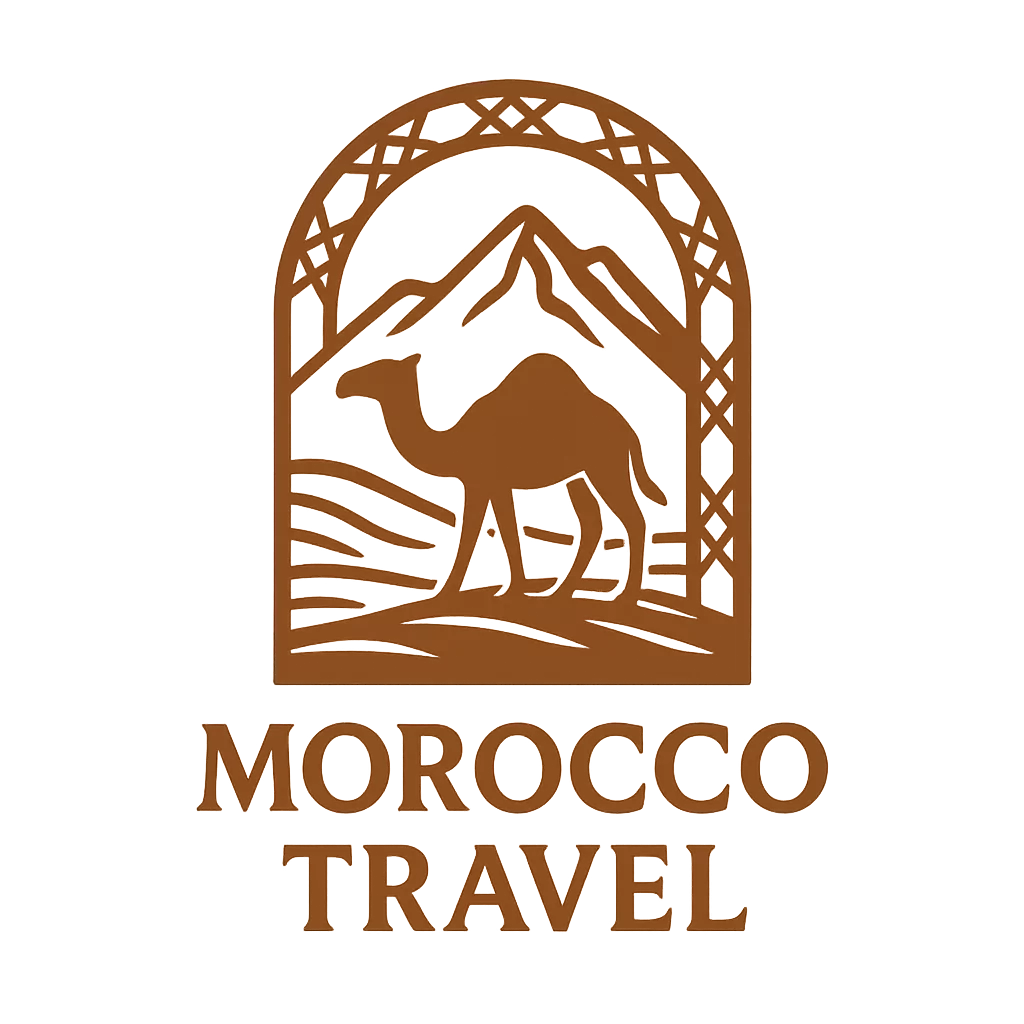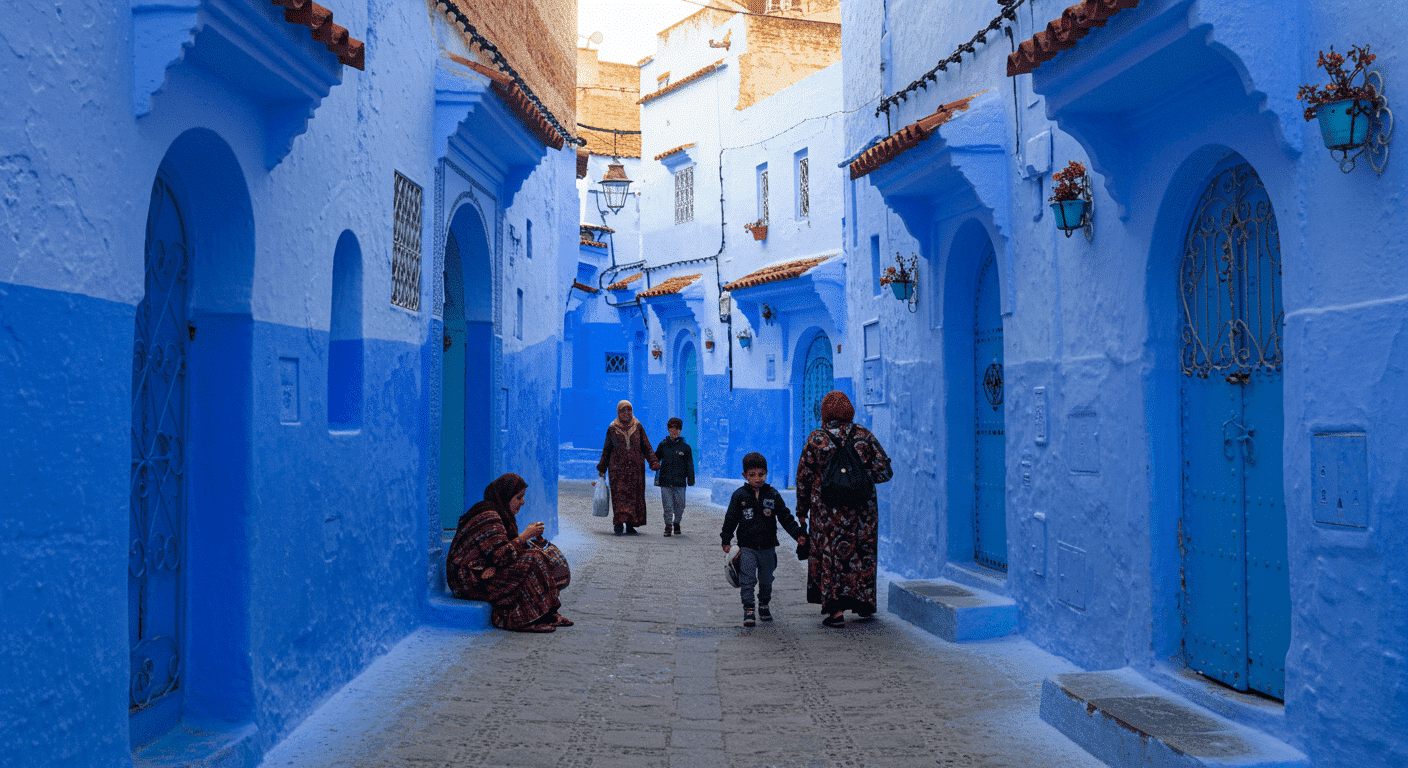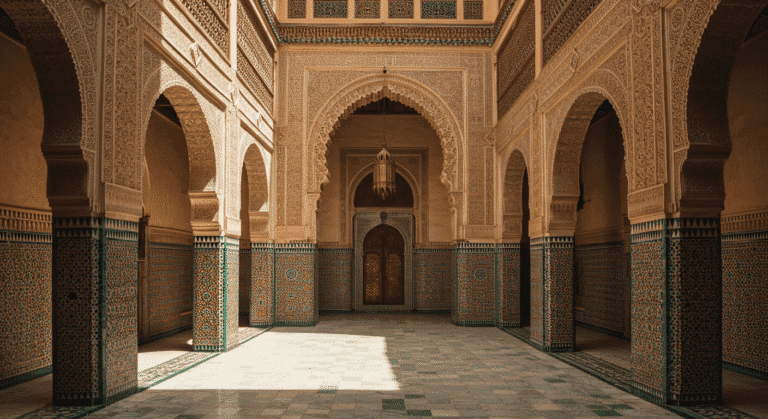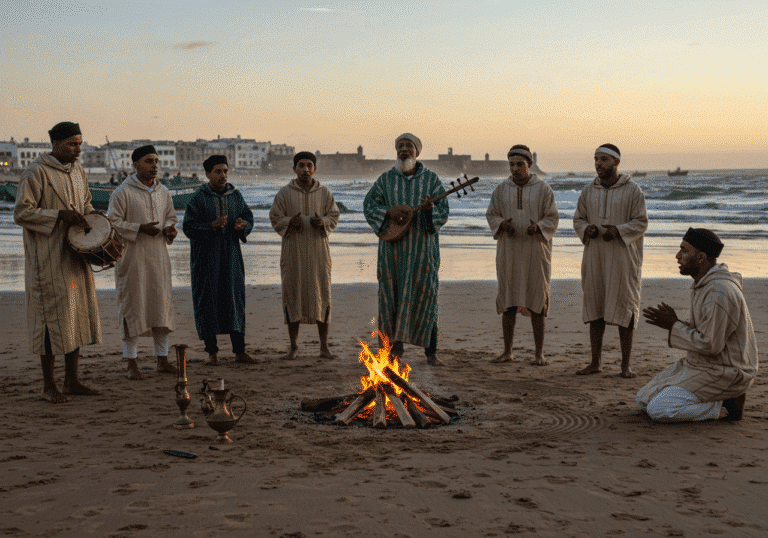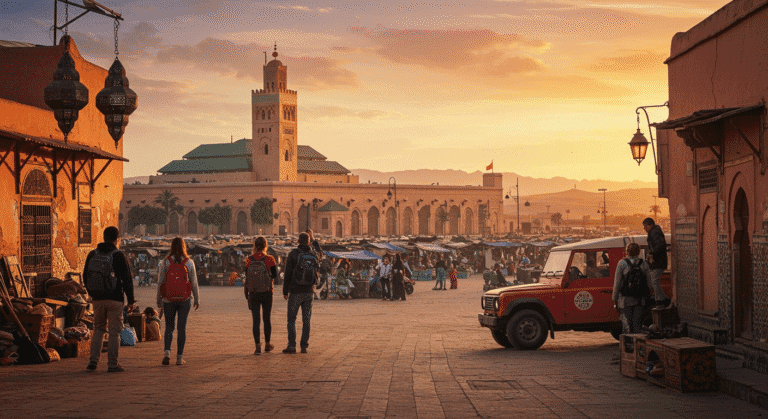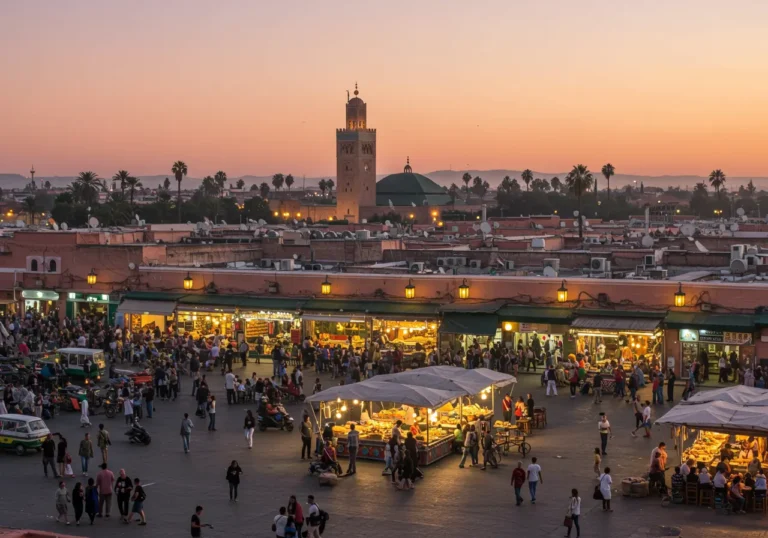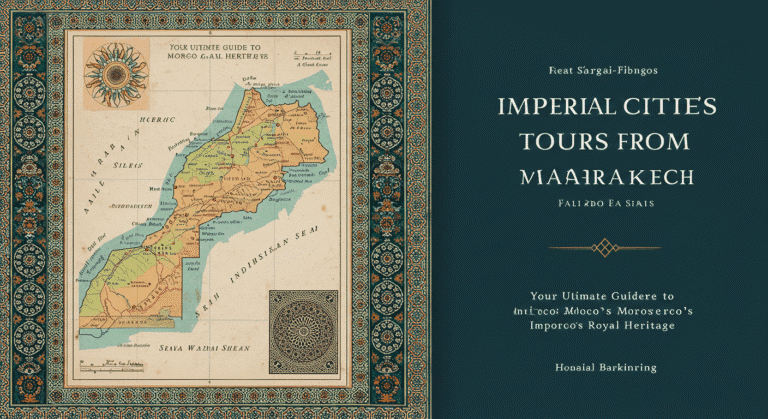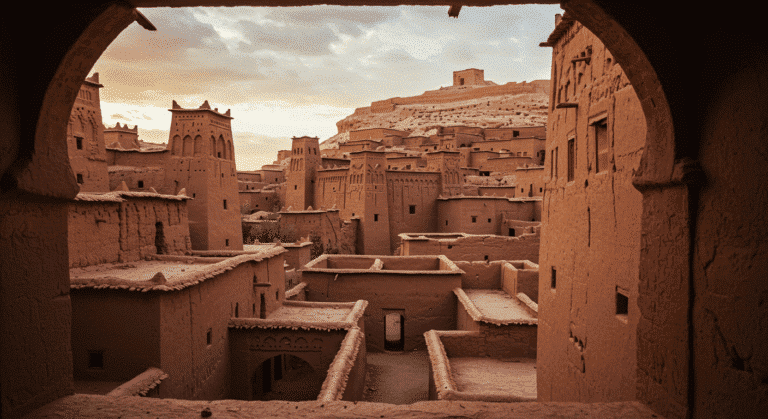Chefchaouen: Explore the Blue Pearl
Have you ever wondered why an entire city would paint itself in various shades of blue? In northwest Morocco, nestled within the dramatic landscapes of the Rif Mountains, Chefchaouen stands as a mesmerizing azure dream that challenges conventional urban aesthetics. This captivating blue-washed mountain town, often called Morocco’s “Blue Pearl,” isn’t just Instagram-famous for its cerulean streets and indigo alleys. Data shows that Chefchaouen receives over 100,000 visitors annually, yet remains mysteriously absent from many traditional Moroccan tourism routes. The town’s distinctive blue palette originated with Jewish refugees in the 1930s, who believed blue symbolized heaven and sky, creating an enduring visual identity that now defines Chefchaouen’s global reputation. As you wander through this ethereal landscape, you’ll discover a destination that offers much more than its photogenic façade.
Travel Checklist / What to Pack
Planning your journey to Chefchaouen requires thoughtful preparation to ensure comfort while exploring its steep, winding pathways. Here’s what you’ll need:
Essentials:
- Comfortable walking shoes with good grip (Chefchaouen’s streets are often steep and sometimes slippery)
- Light, breathable clothing for daytime exploration
- Warmer layers for cool mountain evenings (temperatures can drop by 15°F after sunset)
- Modest attire covering shoulders and knees for visiting religious sites
- Small backpack for daily excursions
- Reusable water bottle to stay hydrated while hiking
- Moroccan dirham currency (ATMs are limited in Chefchaouen)
- Power adapter (Morocco uses type C/E outlets, 220V)
- Sunscreen, sunglasses, and a wide-brimmed hat
- Basic first-aid supplies
Photography Equipment:
- Camera with extra batteries (Chefchaouen’s blue hues deserve more than smartphone photography)
- Wide-angle lens to capture the narrow streets and expansive mountain views
- Polarizing filter to enhance the blue tones against the often bright sunlight
Pro Tips:
- Pack a lightweight scarf that can serve multiple purposes: sun protection, evening warmth, or respectful covering when visiting mosques
- Bring a Moroccan phrasebook or download an Arabic language app with offline capabilities
- Consider a small gift or two for potential homestay hosts if venturing into local accommodation
Seasonal Additions:
- November-March: Waterproof jacket and umbrella (rainy season)
- December-February: Warm jacket and layers (temperatures can drop to 40°F at night)
- July-August: Extra lightweight clothing and portable fan (temperatures can reach 90°F)
Best Time to Visit
Chefchaouen’s mountain climate creates distinct seasonal experiences that affect everything from crowd levels to hiking conditions:
Spring (March-May)
- Optimal season with mild temperatures (60-75°F)
- Vibrant wildflowers bloom against blue backdrops
- April sees 40% fewer tourists than peak summer months
- Accommodations are 15-25% cheaper than summer rates
- Occasional rain showers create atmospheric misty mountain mornings
Summer (June-August)
- Hottest season with temperatures frequently exceeding 85°F
- Highest tourist density (60% of annual visitors arrive during these months)
- Premium pricing for accommodations (30-40% increase)
- Perfect weather for hiking to nearby waterfalls
- Extended daylight hours allow for longer exploration
Fall (September-November)
- Gradually cooling temperatures (55-75°F)
- Harvest season brings fresh produce to local markets
- September offers summer-like conditions with 35% fewer tourists
- October events include local olive harvesting festivals
- Accommodation prices drop by approximately 20% from summer peaks
Winter (December-February)
- Coolest season with temperatures between 40-60°F
- Occasional snowfall transforms the blue city into a magical winter wonderland
- Lowest tourist numbers (70% fewer visitors than summer)
- Some restaurants and shops operate on reduced hours
- Best hotel deals (up to 50% off peak rates)
- Atmospheric fog often envelops the mountains, creating surreal views
Data-Backed Recommendation: For the perfect balance of good weather, reasonable prices, and manageable crowds, visit during the second half of May or late September. These “shoulder weeks” offer temperature averages of 70°F, crowd reductions of approximately 40% compared to peak season, and accommodation savings of 15-20%.
Step-by-Step Itinerary
Day 1: Arrival and First Impressions
Start your Chefchaouen adventure by settling into the unique blue environment:
- Morning: Arrive via taxi or bus from larger cities like Tangier (2 hours), Fez (4 hours), or Casablanca (5-6 hours)
- Early Afternoon: Check into your riad or hotel in the medina (96% of travelers recommend staying within the old city walls for authentic experience)
- Late Afternoon: Orient yourself with a gentle stroll through Plaza Uta el-Hammam, the main square
- Evening: Enjoy a traditional Moroccan dinner at Casa Aladdin, where rooftop seating offers panoramic sunset views over the blue cityscape
- Nighttime: Witness the transformation of Chefchaouen as evening lights create a magical blue-gold ambiance
Hidden Gem: Instead of heading straight to your accommodation, stop at Café Clock for their signature camel burger and panoramic views that will immediately orient you to Chefchaouen’s geography.
Day 2: Blue City Immersion
Dedicate this day to understanding why Chefchaouen’s blues have captivated travelers for generations:
- Early Morning: Begin with sunrise photography at the Spanish Mosque viewpoint (a 20-minute climb offering spectacular citywide vistas)
- Mid-Morning: Explore the kasbah museum to understand Chefchaouen’s history and cultural significance
- Lunch: Sample local goat cheese at one of the medina’s small cafes
- Afternoon: Wander through the northeast section of the medina, where the most vibrant and least-photographed blue alleys await
- Late Afternoon: Visit local artisans creating traditional Moroccan handicrafts
- Evening: Dinner at Bab Ssour, where authentic Moroccan flavors meet mountain ingredients
Cultural Insight: The blue paint is refreshed every spring, with families taking great pride in maintaining their portion of the cityscape. Ask locals about “Izran,” the traditional Riffian poetry that often references the blue city in its verses.
Day 3: Nature and Surroundings
Venture beyond the city to experience the stunning natural environment that cradles Chefchaouen:
- Morning: Hike to God’s Bridge (Pont de Dieu), a natural rock arch with crystal-clear swimming pools below (2-hour moderate hike)
- Midday: Picnic lunch with local ingredients purchased from morning markets
- Afternoon: Visit Akchour Waterfalls, a 30-minute drive and 1-hour hike leading to stunning cascades
- Late Afternoon: Return to Chefchaouen for hammam (traditional bath) experience to rejuvenate after hiking
- Evening: Relax with mint tea at Café Hafa while watching the mountains change colors with the setting sun
Actionable Recommendation: Hire a local guide for the day (average cost: 300-400 dirhams) to access lesser-known viewpoints and hear personal stories about life in the Rif Mountains. Guides can also help navigate the sometimes confusing trails to waterfalls.
Budget Breakdown
Understanding Chefchaouen’s costs helps plan an appropriate budget for this unique destination:
Accommodation (per night):
- Budget: 150-300 dirhams ($15-30) for hostels or basic guesthouses
- Mid-range: 300-700 dirhams ($30-70) for comfortable riads within the medina
- Luxury: 700-1500+ dirhams ($70-150+) for boutique hotels with mountain views
Food (per person):
- Breakfast: 20-40 dirhams ($2-4) for traditional Moroccan breakfast
- Street food lunch: 30-50 dirhams ($3-5) for sandwiches or tajine
- Restaurant dinner: 60-150 dirhams ($6-15) for full meals with drinks
- Bottled water: 5-10 dirhams ($0.50-1)
- Mint tea service: 10-15 dirhams ($1-1.50)
Transportation:
- Taxi from Tangier: 350-500 dirhams ($35-50) for the entire car
- Bus from major cities: 70-150 dirhams ($7-15) per person
- Local petit taxi within city: 10-20 dirhams ($1-2) per ride
- Guided day trip to waterfalls: 400-600 dirhams ($40-60) per person
Activities:
- Kasbah Museum entrance: 60 dirhams ($6)
- Hammam experience: 100-200 dirhams ($10-20)
- Guided city tour: 150-300 dirhams ($15-30) for 2-3 hours
- Cooking class: 250-450 dirhams ($25-45)
Insider Tips to Save Money:
- Stay in guesthouses just outside the medina to save 30-40% on accommodation
- Visit bakeries for fresh breakfast pastries at half the restaurant prices
- Travel in shoulder season for 15-25% discounts on most services
- Negotiate taxi fares before entering the vehicle (expect to pay about 30% less than the initial offer)
- Purchase a local SIM card (40-60 dirhams) rather than international roaming to save on data costs
- Bring a water filter bottle to avoid purchasing multiple plastic bottles daily
Sustainable and Cultural Alternatives
Chefchaouen offers numerous opportunities to experience the destination more deeply and responsibly:
Eco-Friendly Options:
- Stay at Dar Echchaouen, which uses solar power and implements comprehensive water conservation practices
- Join community-led reforestation projects in the surrounding Rif Mountains (contact Association Talassemtane for schedules)
- Use biodegradable soaps when visiting natural waterways, as many locals still collect drinking water from these sources
- Participate in weekly medina clean-up initiatives organized by local environmental groups
Cultural Immersion:
- Attend a weaving workshop with Cooperative Artisanale, where local women preserve traditional Riffian textile techniques
- Learn about natural dye processes used for centuries to create Chefchaouen’s famous wool products
- Participate in bread-making workshops with local families (arranged through most riads)
- Visit during April to witness the Cherry Festival in nearby Stehat village
For Different Travelers:
- Families: Explore the interactive exhibits at the Kasbah Museum, which offers child-friendly historical context
- Solo Travelers: Join community dinners at Casa Hassan for authentic meals with fellow travelers
- Digital Nomads: Work from Café Clock, which offers reliable Wi-Fi and quiet workspaces in morning hours
- Wellness Seekers: Book multi-day retreats at Lina Ryad, combining yoga and traditional Moroccan wellness practices
- Photography Enthusiasts: Join pre-dawn photo walks to capture the city before crowds emerge
Food & Dining Suggestions
Chefchaouen’s culinary scene blends Berber mountain traditions with broader Moroccan cuisine:
Must-Try Local Dishes:
- Tagine with goat meat from nearby Rif Mountains
- Bissara (fava bean soup) served with locally pressed olive oil
- Kalinti (chickpea flour cake) from street vendors near Plaza Uta el-Hammam
- Jben (fresh, soft goat cheese) produced in surrounding mountain villages
- Baghrir (thousand-hole pancakes) drizzled with mountain honey and clarified butter
Restaurant Recommendations:
- Beldi Bab Ssour: For authentic home-style cooking in a quiet blue courtyard
- Café Restaurant Sofia: For affordable tagines and stunning terrace views
- Aladdin Restaurant: For special occasions with premium rooftop dining
- Restaurant Populaire: For no-frills, authentic local cuisine at unbeatable prices
- Café Clock: For fusion dishes blending Moroccan flavors with international techniques
Personal Recommendation: Order the lamb and quince tagine at Restaurant Assaada while sitting on their terrace during sunset. The combination of slow-cooked meat, sweet fruit, and the changing colors over the mountains creates a sensory experience that epitomizes Chefchaouen’s unique charm.
Breakfast Tip: Try the locally made jben cheese with fresh khobz bread and mountain honey at Café Aladin, paired with Moroccan mint tea prepared with herbs from the surrounding mountains. The sweet-savory combination energizes you perfectly for a day of exploration.
Common Mistakes to Avoid
Even well-prepared travelers can stumble into these common pitfalls in Chefchaouen:
Planning Errors:
- Rushing the visit: Data shows 41% of travelers regret allocating only a day trip to Chefchaouen. The town deserves at least 2-3 days.
- Missing the morning light: The blue city is most vibrant during early morning hours (before 9 AM) when sunlight creates dramatic shadows across the blue walls.
- Overlooking water needs: Despite moderate temperatures, the mountain altitude increases dehydration risk.
Cultural Missteps:
- Photography without permission: Always ask before photographing locals, especially women and children.
- Wearing revealing clothing: Though more relaxed than other Moroccan cities, modest dress (covering shoulders and knees) is still appreciated.
- Expecting alcohol availability: Being a traditional town, few establishments serve alcohol. Those that do charge premium prices.
Booking Challenges:
- Last-minute accommodation: The limited number of quality stays within the medina often book 2-3 months in advance during high season.
- Transportation timing: The last bus from Chefchaouen to major cities often departs surprisingly early (around 2-3 PM).
- Using only credit cards: Many smaller businesses, cafes, and the best shops are cash-only enterprises.
Navigation Warnings:
- The winding blue streets are deliberately disorienting (originally designed to confuse invaders). Download offline maps before arriving.
- GPS signals can be unreliable within the densely built medina.
- Street names change frequently between maps, apps, and local usage.
Safety & Travel Tips
Chefchaouen ranks among Morocco’s safest destinations, but awareness enhances any travel experience:
Safety Considerations:
- The town is exceptionally safe, with harassment rates 60% lower than major Moroccan cities
- Stick to well-lit areas after dark, particularly when traveling solo
- Keep valuables secure when photographing panoramic views at popular viewpoints
- Be cautious hiking alone in the Rif Mountains, as trail markings can be inconsistent
- Respect no-photography zones, particularly around certain religious buildings
Practical Tips:
- Download the Maps.me app for the most accurate offline navigation of Chefchaouen’s labyrinthine streets
- Exchange money in larger cities before arriving, as Chefchaouen has limited ATMs with occasional outages
- Purchase a Moroccan e-SIM card online before arrival for immediate connectivity
- Use “La Pharmacie” as your go-to reference point when navigating, as locals recognize it universally
- Learn basic Arabic phrases (particularly greetings) to enhance interactions with older residents
- Carry toilet paper and hand sanitizer, as many public facilities lack these essentials
- Schedule long-distance transportation a day in advance during high season
- Bargain respectfully in markets, typically starting at 60-70% of the initial asking price
Medical Information:
- Chefchaouen has one public hospital and several pharmacies that can handle minor issues
- For serious medical concerns, Tetouan (1.5 hours away) offers better facilities
- Travel insurance covering mountain evacuation is recommended for extensive hiking plans
- Bring any specific medications needed, as specialty pharmaceuticals may be unavailable
Conclusion
Chefchaouen transcends its famous blue aesthetic to reveal a multidimensional destination where Berber culture, mountain traditions, and genuine Moroccan hospitality converge in an azure dreamscape. Beyond Instagram-worthy backdrops, visitors discover a living community where daily rituals unfold against cerulean walls, where mountain springs provide the soundtrack to ancient medina pathways, and where the pace of life invites contemplation. Whether you’re capturing the perfect blue-washed photograph, hiking to hidden waterfalls, or simply sipping mint tea while watching the sun set over indigo-tinted rooftops, Chefchaouen offers an authentic slice of Morocco that stays with travelers long after the blue fades from view.
Have you visited the Blue Pearl of Morocco? Share your Chefchaouen experiences, hidden discoveries, or questions in the comments below. For more detailed guides to Morocco’s enchanting destinations, subscribe to our newsletter and never miss a post about this fascinating North African kingdom.
FAQs
Is Chefchaouen safe for solo female travelers?
Yes, Chefchaouen is considered one of the safest destinations in Morocco for solo female travelers. The town has lower harassment rates than larger cities like Marrakech or Fez. That said, standard precautions like avoiding isolated areas after dark and dressing modestly are recommended.
Why is Chefchaouen painted blue?
The blue painting tradition began in the 1930s when Jewish refugees settled in the area and painted buildings blue, representing the sky and heaven. Some theories suggest the color also repels mosquitoes. Today, the tradition continues primarily for cultural identity and tourism appeal.
Do I need a guide in Chefchaouen?
While not essential, a local guide enhances the experience significantly. They provide historical context, access to local homes and workshops, and help navigate the confusing medina streets. Half-day guided tours typically cost 150-250 dirhams ($15-25).
How many days should I spend in Chefchaouen?
Data from visitor surveys indicates that 2-3 full days is optimal. This allows time to explore the medina thoroughly, take a day trip to surrounding natural attractions, and experience both the bustling daytime atmosphere and peaceful evenings.
Can I drink tap water in Chefchaouen?
Though the mountain spring water supplying Chefchaouen is cleaner than in many Moroccan cities, most travelers are advised to stick with bottled or filtered water to avoid digestive issues. Many guesthouses provide filtered water to refill bottles.
What’s the best way to get to Chefchaouen?
The town has no airport or train station. Most visitors arrive by bus from major cities (Tangier: 2hrs, Fez: 4hrs, Casablanca: 5-6hrs) or hire private transfers. CTM and Supratours offer the most reliable bus services with advance online booking available.
Is it acceptable to photograph local people?
Always ask permission before photographing residents. Many locals are accustomed to tourist photography but appreciate the courtesy of being asked. Some may decline or request a small tip. Respect for privacy is particularly important when photographing women and children.
Can I hike in the Rif Mountains independently?
While some trails near Chefchaouen are well-marked and suitable for independent hiking, hiring a local guide is recommended for safety, especially for longer treks. The mountains have variable weather conditions and sometimes unclear trail markings.
Are credit cards widely accepted?
Within Chefchaouen, cash remains king. While larger hotels and some restaurants accept credit cards, smaller establishments, markets, and taxis operate cash-only. ATMs are available but sometimes experience outages, so bringing sufficient cash is advisable.
What should I bring home from Chefchaouen?
The town is famous for handwoven blankets and garments made from local wool, often dyed using traditional techniques. Leather goods, mountain herbs, locally-produced goat cheese (if properly packaged), and distinctive blue pottery make meaningful souvenirs that support local artisans.
